Finding the right business when conducting an online search can sometimes feel like looking for a needle in a haystack to consumers. Business owners feel a lot of pressure to make sure their needle stands out. Thousands of businesses are competing for the top spot on the search engine results page. What can your business do to ensure a high ranking? The simple answer: search engine optimization.
For those new to digital marketing this task might seem a little daunting, but it doesn’t have to be. There are a number of little things you can do to boost your SEO and make sure your business is on the top of the heap. In this post, we will answer the question, “What is search engine optimization” and provide you with some tips to increase your online visibility.
What is search engine optimization?
Most people have heard of search engine optimization, but do they really know what it means? According to Search Engine Land, SEO is “the process of getting traffic from the ‘free,’ ‘organic,’ ‘editorial’ or ‘natural’ search results on search engines.” The key phrase in that definition is free. While it is true you don’t have to pay for organic or natural search, it will take a lot of work and effort on your part to earn that “free” traffic.
Before we get too far down the road on what you can do to optimize your site for search, let’s discuss the difference between natural search and paid search. Simply put, paid search ads are ads that you pay for within the sponsored links of search engine results.
Paid search ads have an immediate impact. Once you pay for the ad, it will appear at the top of search results. Additionally, paid search is more targeted than organic search. This ensures that you are reaching the right consumers, in the right areas, at the right time.
The downside is that once you stop paying, you lose that position. Your natural search ranking is earned. As long as you continue to make an effort, you should be able to maintain a consistent ranking. Both paid search and natural search provide value and many digital marketing experts suggest using a combination of paid and organic search to increase your business’ online reach.
If you ain’t first, you’re last
Ricky Bobby, the protagonist in Talladega Nights, once opined, “If you ain’t first, you’re last.” This statement is also true when it comes to search engine rankings. On average, the site in the top spot of any given search engine results garners 30% of all click-through traffic and 91.5% of all clicks on organic results occur on the first page. What that means is the lower your business ranks in organic search, the less likely it is to be found by potential customers.
Where do I start?
Now that we’ve discussed the what and why of search engine optimization, let’s talk about the how. Below are a few things that you can do to improve your search engine ranking and increase visibility by optimizing search engine optimization.
Also, if you want to start in the world of search engine optimization, we really recommend you some of this Local SEO tools. Now, let’s dive in to the steps to improve your SEO.
Create relevant content
The goal of any search engine is to connect searchers with the site that best answers their question. Filling your website with relevant keywords will determine whether or not your site can answer the searcher’s question. It’s important to avoid keyword stuffing. The algorithms will recognize when this is happening and your ranking could suffer as a result.
Optimize user experience
Search engines are also looking for sites that are fast and easy to navigate. If it’s difficult to find content on your site, it takes too long to load, or you have a high bounce rate, your search ranking could take a hit.
Consistent URL structure
The structure of your site’s domain and URL is a major contributing factor to its SEO ranking. Whenever possible you should have a single domain and subdomain. Doing so will make it easier for search engines to find what they are looking for on your site. Additionally, you should make your URLs easy to read and whenever possible include keywords in them. For a more in-depth look at best practices for structuring URLs for SEO, check out this post by Rand Fishkin on Moz.
Include meta description and title tags
Including meta descriptions and title tags won’t necessarily affect your search engine ranking. When drafting them you don’t need to focus on SEO, you need to write copy that converts. However, just because they don’t affect search ranking doesn’t mean they shouldn’t be part of your SEO strategy. Their purpose is to entice searchers to click on your link. If searchers aren’t clicking on your link, what good does it do to have a high ranking?
Don’t forget mobile users
In the US and 10 other countries, there are more Google searches conducted via mobile devices than desktops. As a result, Google prefers sites with a responsive design. This is good news for users because sites with responsive design will display content correctly regardless of what device the customer is using.
Optimize for local
Speaking of mobile searches, many of them occur when consumers are on the go and actively looking for a business with the intent to purchase. Businesses need optimize for local search so they can capitalize on these micro-moments. There are three major factors that make up Google’s local search algorithm, including the relevance of search terms, distance to the searcher, and prominence of the business.
The first two are relatively self-explanatory, but prominence isn’t as clear. A business’ prominence is made up of how well known it is offline as well as the amount of information Google has about it online, including how many online reviews they have. For more information on how to optimize your business for local search check out this blog post.
Don’t be afraid to ask for help
The tactics described in this post are a good starting point, but there is so much more that makes up search engine optimization. If you need help when you’re just getting started, don’t be afraid to ask. It might even be beneficial to work with a digital marketing or SEO agency to make sure you’re starting off on the right foot.
Continue learning with these articles
Hopefully, by now you have a solid understanding of Google My Business and you can continue reading more articles that will help your brand or business on our Blog. Create a Google My Business account and help expand your business.








